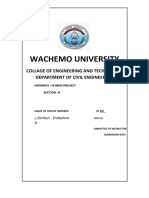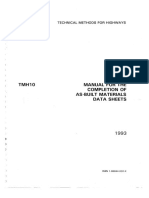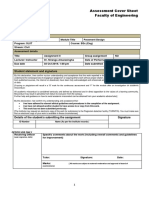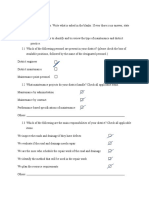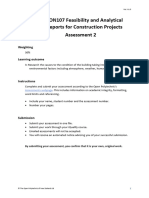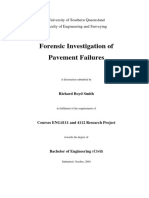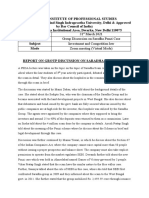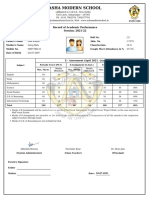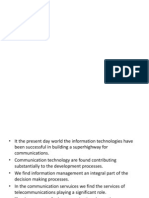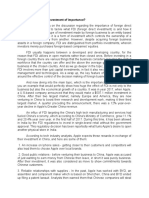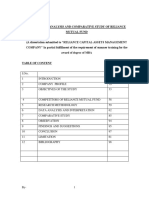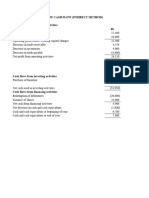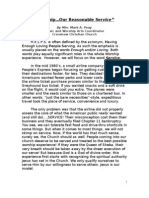Engineering Report
Uploaded by
Katlego ThaboEngineering Report
Uploaded by
Katlego ThaboForm No.
:
Effective Date:
APP-REG-FORM- Revision No.: 2
14/02/2022
C1
Subject: REGISTRATION AS A PROFESSIONAL ENGINEERING
TECHNICIAN
Compiler: Approving Officer: Next Review Date:
Page 17 of 44
MB Mtshali EL Nxumalo 14/02/2026
Form C2.3 ER
Engineering Report
Use this form to report in about 100 words per criterion under Outcomes 1 to 11 below on a recent engineering task, part of a project
or complete project to which you have made a significant contribution. The report may cover conceptualization, design and analysis,
specification, tendering and adjudication, manufacturing, project and construction management, commissioning, maintenance,
measurement and testing or planning at a well-defined level. Please also provide a sample relevant calculations and drawings as an
addendum which is limited to two A4 pages.
Use Appendix A of the Discipline Specific Training Guide R-05-PN to assist in the interpretation of the criteria
Name of Applicant: Thabo Eugene Mphatsoe
Designation of Work: Routine Road Maintenance of the N2 Section 7&8 between Rondeheuwel and
(<15 words) Natures Valley
Date of Work: 2 March 2020 to 31 May 2022
Engineering brief and The repair of a failed flexible pavement structure by milling out the surface and
objective: (< 30 words) substate to a depth of 150mm and backfilling with BTB and 40mm medium
asphalt.
Environment: Industry; Transportation, Roads Infrastructure for the South African National Roads
Laboratory; Theory; Simulation, etc. in Agency SOC Limited (SANRAL)
<15 words)
Short Summary: The road was laden with deep ruts exceeding 20mm, potholes and wet base
(State engineering problems; solutions due to water infiltration on coarse surface. The improvement of the pavement
in < 30 words) was to eliminate deterioration of the road and promote safe movement of
vehicles.
Budget: (<10 words) R53Million
Well-defined engineering problems have the following characteristics:
a) can be solved mainly by practical engineering knowledge, underpinned by related theory;
and one or more of:
b) are largely defined but may require clarification;
c) are discrete, focused tasks within engineering systems;
d) are routine, frequently encountered, may be unfamiliar but in familiar context;
and one or more of:
e) can be solved by standardised or prescribed ways;
f) are encompassed by standards, codes and documented procedures; requires authorisation to work outside
limits;
g) information is concrete and largely complete, but requires checking and possible supplementation;
h) involve several issues but few of these imposing conflicting constraints and a limited range of interested and
affected parties;
and one or both of:
i) requires practical judgement in practice area in evaluating solutions, considering interfaces to other role-
players;
j) have consequences which are locally important but not far reaching (wider impact are dealt with by others).
Well-defined engineering activities (WDEA) have several of the following characteristics:
a) Scope of practice area is defined by techniques applied; change by adopting new techniques into current practice;
b) Practice area is located within a wider, complex context, with well-defined working relationships with other parties and
disciplines;
c) Work involves familiar, defined range of resources, including people, money, equipment, materials, technologies;
d) Require resolution of interactions manifested between specific technical factors with limited impact on wider issues;
e) Are constrained by operational context, defined work package, time, finance, infrastructure, resources, facilities,
standards and codes, applicable laws;
f) Have risks and consequences that are locally important but are generally not far reaching.
CONTROLLED DISCLOSURE
It is the responsibility of the user to ensure that the latest version is used. The latest version will be published on ECSA Document Management system.
QM_TEM_003 Rev 0 27-11-2017
Form No.:
Effective Date:
APP-REG-FORM- Revision No.: 2
14/02/2022
C1
Subject: REGISTRATION AS A PROFESSIONAL ENGINEERING
TECHNICIAN
Compiler: Approving Officer: Next Review Date:
Page 18 of 44
MB Mtshali EL Nxumalo 14/02/2026
Outcomes and Criteria
Outcome 1: Define, investigate and analyse well-defined engineering problems encountered in
your work:
1.1 State how The instruction from the Client was to do pavement layer works on failed surface in order to
you interpreted prevent the road from deteriorating further. I looked at the information I gathered from site along
the work with pictures taken and found that the nature of surface and pavement structural problems
instruction needed to be properly analysed using assessment manuals and then quantified.
received,
checking with
your client or On my analysis of the problems, I explained to the Route Manager that one of the reasons for the
supervisor if surface deteriorating at its rate was based on the high traffic volumes imposed on a wet base.
your
interpretation is I finally compiled the report for the Client and submitted it for their review and input.
correct.
1.2 Describe I was a visual assessor, evaluating the existing conditions of the flexible pavement of the National
how you Route. The total length was 138km divided into 2 sections. I identified problems using TMH9
analysed, which were addressed in the preliminary and detailed design report. High traffic volume was one
obtained and of the problems identified. The defects encountered consisted of:
evaluated
further Bleeding
clarifying Rutting
information, Patch failures
and if the
Transverse cracks and longitudinal cracks
instruction was
revised as a Crocodile cracks
result. Pedestrian issues
Damaged culverts and floors
Damaged road signs
When I checked the severity of the defects that I mentioned above I realised that the problem
could have extended to the underlying layers as there was wide and deep rutting in certain
sections. Using a 2m straight edge I measured the rutting depths and noticed that some were
greater than 10mm. That step was necessary in deciding what corrective actions will be taken,
bearing the cost in mind.
From the evaluation I made I saw that the road was frequently under heavy traffic of trucks and
buses, this traffic was generated from transportation of goods from the coast ;because of these
findings, my advice was that for ruts between 15mm and 20mm, a 40mm medium wearing course
be used and where ruts are deeper than 20mm, a 150mm base patch should be done this
primarily to the wet base.
Outcome 2: Design or develop a solution to well-defined engineering problems encountered in
your work:
2.1 Describe ETB and BTB
how you The following had to considered when doing these pavement repairs:
designed or
developed and Cost
analysed Time
alternative Quality
approaches to
do the work.
Impacts
In order to prevent the road from deteriorating further. On the sections that were showing surface
checked. deterioration a 40mm medium wearing course was used to repair however on sections that had
Calculations upscale we had to decide whether BTB or ETB pavement layer repairs had to be done.
CONTROLLED DISCLOSURE
It is the responsibility of the user to ensure that the latest version is used. The latest version will be published on ECSA Document Management system.
QM_TEM_003 Rev 0 27-11-2017
Form No.:
Effective Date:
APP-REG-FORM- Revision No.: 2
14/02/2022
C1
Subject: REGISTRATION AS A PROFESSIONAL ENGINEERING
TECHNICIAN
Compiler: Approving Officer: Next Review Date:
Page 19 of 44
MB Mtshali EL Nxumalo 14/02/2026
attached.
The advantages of ETB is that it is a more labour intensive, water susceptibility and improves
cohesion by binding fine aggregate. Doing ETB repairs would take longer to complete and since
this was a routine maintenance project the road would have to be opened to traffic on the same
day. Traffic accommodation would be required beyond what the scope of RRM caters for.
Also considering the time implications to wait for an approval of mix designs and order required
bituminous product to mix the product on site. This option poses more problems requiring more
precision/expertise from the contractor thus I thought of chances of the quality being
compromised were more. BTB would be supplied by a batch plant which would make the mix a
better lab-controlled product that would give more accurate results. It is made from high quality
materials to achieve strength and durability. It is also a better product to use in places that have
high traffic volumes compared to ETB.
Considering all the above: BTB was a much better product to use than ETB. (Calculations on
annexure)
2.2 State what Looking at the state the road was in and the rate of deterioration; Some surface patches would
the final have to be upscaled to 150mm BTB patches due to infiltrated water into the substrate.
solution to Subsequently the wet base was affected by the high traffic volumes on a daily bases, and the
perform the increase in traffic volumes as the holiday season was approaching.
work was,
client or your
supervisor in Considering all this we concluded that the solution was feasible as it would cost more to do the
agreement. BTB patches to existing road level. The solution was accepted by the Client as proposed.
Outcome 3: Comprehend and apply the knowledge in established engineering practices and
knowledge specific within your practice area as applied in your task:
3.1 State what Construction Methods 1 and Construction Materials:
NDip level I ensured that Hot-mix asphalt from the batch plant arrived on site with temperatures as per
engineering
design parameters in our case 160⁰C and well mixed with no segregation. The temperature of
standard
procedures the asphalt was checked in the truck, paver and on the mat using a calibrated Tel-Tru
and systems thermometer. It is important that once the truck arrives, the pre-mix remains hot during after
you used to placing. Directly after being placed, it must be compacted using static rollers (pneumatic- tyre
execute the roller and steel wheeled rollers).
work, and how
NDip level The temperature during compaction is an important parameter that determines the volumetric
theory was
properties of the compacted asphalt pavement. Using an improper compaction temperature can
applied to
understand cause problems on the dense-graded asphalt mixture performance. If the compaction
and/or verify temperature is less than the desirable temperature, it can potentially reduce the density and
these increase the air voids, thus reduce the pavement strength.
procedures.
The temperature must be constantly and closely monitored and captured. A calibrated nuclear
gauge must be utilised for process control however I ensured that cores were drilled from the
compacted asphalt within 24hours when the temperature of the road is 20⁰C or less, for quality
assurance.
3.2 Give your Traffic accommodation in relation to asphalt patches and theory.
own NDip level
theoretical Because any work activity which results in a decrease of the road space available to the travelling
CONTROLLED DISCLOSURE
It is the responsibility of the user to ensure that the latest version is used. The latest version will be published on ECSA Document Management system.
QM_TEM_003 Rev 0 27-11-2017
Form No.:
Effective Date:
APP-REG-FORM- Revision No.: 2
14/02/2022
C1
Subject: REGISTRATION AS A PROFESSIONAL ENGINEERING
TECHNICIAN
Compiler: Approving Officer: Next Review Date:
Page 20 of 44
MB Mtshali EL Nxumalo 14/02/2026
calculations public should be preceded by an adequate number of temporary road signs (Warning zone)
and/or according to SARTSM (South African Road Signs Manual). Before pavement repairs the
reasoning on workspace was always preceded by warning signs to make public users aware.
why the
application of Traffic accommodation
this theory is
considered to The number and spacing of these signs are dependent on the capacity of traffic passing at that
be correct time and design speed of the road. All signs should have retro- reflective stickers’ backgrounds
(Actual and regulatory and warning signs should have retro- reflective borders. I used the following
examples). standard guidelines(theory):
South African Road Traffic Safety Manual 1999 (Volume 2 chapter 3).
COLTO-1500: Accommodation of traffic.
Traffic accommodation during construction was to be carried out as two-way traffic and in some
sections a Stop/Go was put in place. Before any construction could start I observed that this was
a very busy route due to all the trucks and because the towns are close to each other, people
travel to and from work in the morning and in the afternoon.
Implementing a stop/go in the morning and afternoon in areas that require it would be a problem
because it was going to frustrate the road user due to the delays. I then suggested that where
traffic accommodation would cause us to have one-way traffic the work must commence when
traffic volumes have decreased.
This made it possible to accommodate the traffic in both directions and eliminated safety issues
and frustrations that could arise from the public that is common to the route.
In sections where traffic could still flow in both directions because it was a 4-lane road we simply
closed the lane that we were working on using temporary road signs, flagmen and delineators.
Delineators were placed 5m c/c apart. Placing of all temporary road construction signs was done
according to the project specifications which are in line the South African Road Traffic Signs
Manual (SARTSM) Volume 2 Chapter 13. We ensured that all surface repairs are complete while
there is visibility and before the traffic volumes increased.
Asphalt Compaction
The right compact of a new asphalt layer is important as it reduces the amount of air voids in the
asphalt layer and to move the aggregate in the layer closer together. The three important
CONTROLLED DISCLOSURE
It is the responsibility of the user to ensure that the latest version is used. The latest version will be published on ECSA Document Management system.
QM_TEM_003 Rev 0 27-11-2017
Form No.:
Effective Date:
APP-REG-FORM- Revision No.: 2
14/02/2022
C1
Subject: REGISTRATION AS A PROFESSIONAL ENGINEERING
TECHNICIAN
Compiler: Approving Officer: Next Review Date:
Page 21 of 44
MB Mtshali EL Nxumalo 14/02/2026
machinery equipment for hot mix asphalt compaction are: the paver screed, the steel wheeled
roller and the pneumatic tire rollers. Each machine compacts the hot mix asphalt by two principal
means:
By applying its weight to the HMA surface and compressing the material underneath the
ground contact area. Since this compression will be greater for longer periods of contact,
lower equipment speeds will produce more compaction, higher equipment weight will
also increase compression.
By creating shear stress between the compressed material underneath the ground
contact area and the adjacent uncompressed material. When combined with equipment
speed, this produces shear rate. Lowering equipment speed can decrease the shear
rate, which increases the shearing stress. Higher shearing stresses are more capable of
rearranging aggregate into denser configurations.
Depending on the job, other equipment may be necessary to use when asphalt paving. The
machines listed above are the essential pieces of equipment used to pave highways, parking lots
and other paved areas.
Outcome 4: Manage part or all of one or more well-defined engineering activities embodied in
your work:
4.1 State how My responsibilities included conducting safety checks every day. I checked all the previous day’s
you managed daily maintenance report, traffic accommodations and route patrol registers.
yourself, During the day I would be in the office checking if there is any correspondence I needed to attend
priorities,
to, recording daily diaries and admin process that need to be put in place. I go to site on a formal
processes and
resources in request from the contractor for me to do inspections on work during and once completed (e.g. if
doing the work they have erected new fences, repaired guardrails. The contractor will write an inspection request
(e.g. bar chart). and I will inspect to see if the work is done according to standard.
Finally, in the afternoon I would drive through site again to check if the traffic signs are still in
accordance with SARTSM so that we leave the road in a safe condition.
4.2 Describe I am responsible for quality control and acceptance of the work this includes monitoring
your role and construction processes. Once a month I prepare appendices for site meetings, site meeting
contribution in minutes and technical minutes. I am responsible for the daily inspection of traffic accommodation
the work team. and daily traffic reports on site accidents. Once a month I also inspect the emergency trailer,
route patrol equipment and site vehicles, to ensure all necessary equipment is in place. I also
liaise with the Public Liaison Officer for all Sub-Contractor’s monthly performance.
I do measurement of quantities and reach an agreement with the contractor and verify the
contractor’s monthly claim. I manage and complete activities to the Client’s expectations and
satisfaction.
I give feedback to the Route Manager on daily activities e.g. (building of gabions and layer
construction). Any work that I think demands his expertise I bring to his attention.
I mentor students on how to calculate quantities, conduct site inspections and monitor works of
layer repairs.
Outcome 5: Communicate clearly with others in the course of your engineering activities (well-
defined engineering work):
5.1 State how I sent a weekly report to the Client, Engineer, Contract’s Manager and Site Agent keeping all
you presented stakeholders updated about different activities and progress on site.
your point of I compiled as-built data for all structural work, signage, fences, bridges and layer repairs to be
view and
used in the road conditions report. I ensured that full and accurate standardized records are kept
compiled
reports after of all site activities/meetings.
completion of The contractor had to fill in request forms every time before inspection of any section. This
CONTROLLED DISCLOSURE
It is the responsibility of the user to ensure that the latest version is used. The latest version will be published on ECSA Document Management system.
QM_TEM_003 Rev 0 27-11-2017
Form No.:
Effective Date:
APP-REG-FORM- Revision No.: 2
14/02/2022
C1
Subject: REGISTRATION AS A PROFESSIONAL ENGINEERING
TECHNICIAN
Compiler: Approving Officer: Next Review Date:
Page 22 of 44
MB Mtshali EL Nxumalo 14/02/2026
the work. procedure was effective for quality control measures at the completion of each task.
5.2 State how I always communicated verbally then follow it up by sending an e-mail with a set of quantities,
you compiled small scale drawings and pictures for clarification of the work. At times I also used e-mails to
and issued correct the contractor if there was work that was not done correctly on site. Issuing formal written
instructions to instruction such as penalties for traffic offences or monthly items not complete I request the Route
entities working
on the same
Manager to issue them on a standard instruction form.
task.
Outcome 6: Recognise the reasonably foreseeable social, cultural and environmental effects of
your well-defined engineering activity (task):
6.1 Describe Environmental impact.
the social, As this was a surface repair project once the milled out material was removed. The surface was
cultural and cleaned using a skid steer broom on a bobcat and this caused dust. After it was clean from loose
environmental
aggregates the next step was to tack the surface. During the tack-coating I instructed the
impact of this
engineering contractor to be cautious not to spray the tack in windy conditions. The result could’ve led in
activity. undue spillage to the road, affect passing traffic, plants and contaminate the land.
Socio-economic
Although the project is a temporary project the Traffic Accommodation was affect to certain
degree. The project also benefited society as it created employment and will leave the citizens
with skills that they can use in long term.
Cultural
There are sack-manne rasta people in the area who walk barefoot in between towns. During the
construction we had to respect and assist them not to walk too close to the asphalt as it would
burn their feet. I instructed the two students and the traffic safety officer to be on the lookout for
the sack-manne rasta and if there are any nearby they should be escorted them away from the
work.
6.2 State how I understand the importance of Safety, Health, Environment and Quality (SHEQ) management.
you After assessing the risk posed by cleaning of the exposed material I pre-cautioned and
communicated recommended that all employees should wear disposable masks, this is in addition to their
mitigating personal protective gear. I also cautioned that earpieces must be given to employees involved
measures to with the paver which produces high noise levels
affected parties
and acquired
stakeholder Firstly consulted with the safety consultant and he made me aware that there is NIHL Regulations
engagement. (Noise Induced Hearing Loss Regulations) which stipulate that where employees may be
exposed to noise levels above the noise-rating limit (regardless of whether hearing protection is
worn) an employer must conduct a Noise Assessment / Survey. This must be done by an AIA
(NIHL Regulation 6). So, I advised the contractor to find quotation from suitable companies that
qualify to conduct this survey.
For bituminous substances, hazardous chemical/lubricating fluid, spillages were to be prevented.
Under very high-pressure wind an activity that involved using bitumen like tack coating had to be
put on hold.
Outcome 7: Meet all legal and regulatory requirements and protect the health and safety of
persons in the course of your well-defined engineering activity (task):
7.1 List the I ensured that the traffic accommodation took into account the provisions of the latest edition of
major laws and the South African Road Traffic Safety Manual (SARTSM). The latest version of accommodation of
regulations traffic being volume 2, chapter 13 of the June 1999 edition and Standard specifications of routine
applicable to
CONTROLLED DISCLOSURE
It is the responsibility of the user to ensure that the latest version is used. The latest version will be published on ECSA Document Management system.
QM_TEM_003 Rev 0 27-11-2017
Form No.:
Effective Date:
APP-REG-FORM- Revision No.: 2
14/02/2022
C1
Subject: REGISTRATION AS A PROFESSIONAL ENGINEERING
TECHNICIAN
Compiler: Approving Officer: Next Review Date:
Page 23 of 44
MB Mtshali EL Nxumalo 14/02/2026
this particular road maintenance volume 2.
activity and
how health and I also ensured that Occupational Health and Safety induction was implemented by the Safety
safety matters
Officer for all the site staff in accordance to the regulations of Occupational Health and Safety
were handled.
(OH&S) Act 1993.
The National Veld and Forest Fire act 101 of 1998
Bush fires that are uncontrolled are a risk to life, property, the environment, one’s business or
livelihood and to tourism, generally, in the long run. It was a risk with the fires that took place in
2017 with the Knysna fires. I ensured that fire breaks were done in the surrounding areas with all
SANRAL properties.
7.2 State how During the time when the Contractor was not performing by completing Job Instructions on site I
you obtained received advice from the Contracts Engineer to issue a Site Instruction giving the Contractor 14
advice in doing days to fix the work. The work was still not complete within the 14 days and the Contracts
risk Engineer using Fédération Internationale Des Ingénieurs-Conseils (FIDIC) issued a 15.1 Notice
management
to correct. After 28 days from the time the notice to correct was issued the Contracts Engineer
for the work
and elaborate further issued a 15.2 Termination by Employer. The decision to terminate the contract was based
on the risk on information I provided to the Contract Engineer and the Client.
management
system I also received advice from the health and safety consultant for safe work practice on the
applied. regulations that govern the type of project I am working on which is road construction. I then
personally observed and conducted more research. The risk management system that is applied
is divided into 2 sections which are the baseline risk assessment and client’s health and safety
specifications as per construction regulation 5(1)(b) 2014. The baseline risk assessment is used
to identify any risk associated with any hazard at a construction site in order to identify the steps
needed to be taken to remove, reduce or control such hazards. Clients health and safety
specifications outlines the scope of the work and how to carry out each construction activity in a
manner that is compliant to the OHS rules
Outcome 8: Conduct engineering activities ethically in executing your work:
8.1 State how During the replacement/repair of guardrails, the hole for the posts should be dug at least 1m into
you identified the ground. The subcontractor dug a shallow hole, less than 1m deep, then cut the posts to give
ethical issues the illusion that they are deeper in the ground than they actually were. The sub-contractor then
and affected filled the hole with concrete before inspection. During inspection I realised that the posts were not
parties and their
interest and
as firm as they should be, I then noticed at the back of his vehicle pieces of guardrail posts that
what you did were cut. I requested the sub- contractor to remove the posts in the ground, upon their removal I
about it when a saw that they had cut the posts in half. This compromises the quality of work and it affects the
problem arose. strength of the guardrails. I ordered all the posts that were cast on that day to be removed and
the work to be redone. I communicated with my Route Manager and Site Agent concerning this
and further action was taken.
8.2 Confirm that I Thabo Eugene Mphatsoe confirm that I am conversant (familiar) and in compliance with ECSA’s
you are con- Code of Conduct.
versant and in
compliance with I understand the importance of applying my knowledge and skills in the interest of the public and
ECSA’s Code of environment. I execute my work with integrity and in accordance with the accepted norms of the
Conduct and
why this is
professional conduct. I strive to always improve my professional skills and those of my sub-
important in your ordinates. Having looked at the code of conduct I do encourage excellence within the engineering
work. profession, and I do not prejudge public health and safety.
Outcome 9: Exercise sound judgement in the course of well-defined engineering
activities encountered in your work:
CONTROLLED DISCLOSURE
It is the responsibility of the user to ensure that the latest version is used. The latest version will be published on ECSA Document Management system.
QM_TEM_003 Rev 0 27-11-2017
Form No.:
Effective Date:
APP-REG-FORM- Revision No.: 2
14/02/2022
C1
Subject: REGISTRATION AS A PROFESSIONAL ENGINEERING
TECHNICIAN
Compiler: Approving Officer: Next Review Date:
Page 24 of 44
MB Mtshali EL Nxumalo 14/02/2026
9.1 State the During the construction of private residences. I came across where the contractor was preparing to
factors cast concrete for the foundation but he did not use the correct formwork and the reinforcement
applicable to was not tied properly. The formwork used had spacing in between therefore it would cause the
the work, their concrete to escape. I instructed the contractor to fix the reinforcement and use the correct
interrelationshi
p and how you
formwork. I made sure quality control measures were always taken and errors on technical,
applied the construction methods, differences in quantities, omissions and / or changes are corrected and
most important adhered to.
factors.
9.2 Describe During pavement repairs the paver broke and the contractor called the mechanic to come and fix
how you it. By the time the paver was fixed the asphalt temperature was between 100⁰C to 110⁰C. I told
foresaw work
the Site Agent that the temperature is low and we should not pave the material but to rather use
consequences
and evaluated
material with a warmer mix. He immediately started to talk to me with a loud and inappropriate
situations in voice. I stepped away from him and calmly alerted my Route Manager.
the absence of
full evidence. The Site Agent paved the asphalt material anyway and could not achieve the right compaction.
This was wrong because the surface would ravel, resulting in poor surfacing, reducing the
lifespan of the pavement. I addressed all parties with an email regarding what occurred on site.
Eventually the section was milled out and re-paved following proper procedures.
Outcome 10: Be responsible for making decisions on part or all of well-defined engineering
activities included in your work:
10.1 Show how
you used NDip During the visual assessment for pavement layer repairs. I quantified the amount of work to be
theoretical done. The brief calculations done below include the hauling of milled out material. The conversion
calculations to factor of asphalt from m3 to ton differs from region to region and asphalt plant. The conversion
justify factor which is to convert the amount cubic meters to tons was given to me by the batch plant and
decisions taken it was 2.52.
in doing
engineering
work. Attach Below is a summary of how I got the quantities to be paved.
actual
calculations
Calculations for Wearing Course:
Calculations for BTB patches
CONTROLLED DISCLOSURE
It is the responsibility of the user to ensure that the latest version is used. The latest version will be published on ECSA Document Management system.
QM_TEM_003 Rev 0 27-11-2017
Form No.:
Effective Date:
APP-REG-FORM- Revision No.: 2
14/02/2022
C1
Subject: REGISTRATION AS A PROFESSIONAL ENGINEERING
TECHNICIAN
Compiler: Approving Officer: Next Review Date:
Page 25 of 44
MB Mtshali EL Nxumalo 14/02/2026
Summary of calculations:
10.2 State how Fire Breaks
you took SANRAL has a lot of properties throughout the country. Some of these properties are in between
responsible farms far away from the National Routes. I was told about these and arranged a meeting with the
advice on any
contractor, fire brigades and local farm owners. I was told that the fire breaks had to be done on
matter falling
outside your all SANRAL properties on the N5. I liaised with the contractor and local farm owners to source 3
own education quotations that were submitted to SANRAL through a Work Authorisation to carry out the work. In
and experience. the past failing to do these fire breaks has cost SANRAL millions of rand in claims. If they are not
maintained and a fire starts on one of the properties it can lead to loss of cattle and human lives.
A contractor with the lowest bid was appointed and work was carried out and completed without
any accidents.
10.3 Describe One of my primary duties of site supervision was to measure and control quantities on site.
how you took Control by means of doing my own original calculations not just to check the contractor’s
responsibility quantities. These calculations were based on physical measurements with notes from my site
for your own diary. As soon as the contractor submitted his calculations to me, the calculations were compared
work and
and disputes resulting from factors such as computer programme, unclear instructions and as-
evaluated any
shortcoming in build were settled. It gave me an advantage to do my quantities calculations well in advance
your output. because if that had not been the case then I would have been in a position of accepting his
quantities without checking them thoroughly due to time constraints.
Outcome 11: Undertake professional development activities sufficient to maintain and extend
your competence.
CONTROLLED DISCLOSURE
It is the responsibility of the user to ensure that the latest version is used. The latest version will be published on ECSA Document Management system.
QM_TEM_003 Rev 0 27-11-2017
Form No.:
Effective Date:
APP-REG-FORM- Revision No.: 2
14/02/2022
C1
Subject: REGISTRATION AS A PROFESSIONAL ENGINEERING
TECHNICIAN
Compiler: Approving Officer: Next Review Date:
Page 26 of 44
MB Mtshali EL Nxumalo 14/02/2026
11.1 State I am constantly studying engineering related courses, reading books and newsletters that are
what strategy industry related to learn of new and improved ways or approaches to civil engineering works. This
you have helps me to adopt ways to respond and give better advice where needed.
independently
adopted to
enhance your Furthermore I am also intending on furthering my studies to become an Asphalt specialist.
own
professional
development.
11.2 State the Q&A Consulting prides itself in seeing continuous development in young engineers. The values
philosophy of and principles instilled in all employees are that of providing quality services to all their clients. To
your employer keep up to date with the latest development in the engineering field it provides assistance for the
in regard to employees to go on courses and further their careers. All of the courses are ECSA and
your
professional
SACPCMP accredited.
development.
Evidence of your competency development plan and independent learning ability must be given in the Initial Professional
Development Report, Form C5 IPD
Signature of Applicant: ____________________________ Date: 11/10/2022
Signature of Mentor / Supervisor: _____________________________
Name of Mentor/Supervisor printed:___________________ Tel. No.:____________________
CONTROLLED DISCLOSURE
It is the responsibility of the user to ensure that the latest version is used. The latest version will be published on ECSA Document Management system.
QM_TEM_003 Rev 0 27-11-2017
You might also like
- Form C2.3 ER - Engineering Report - Rev 1 - July 2022No ratings yetForm C2.3 ER - Engineering Report - Rev 1 - July 202215 pages
- 5F2 LAB REPORT PAVEMENT DISTRESS IDENTIFICATION - Compressed - Zul HaninNo ratings yet5F2 LAB REPORT PAVEMENT DISTRESS IDENTIFICATION - Compressed - Zul Hanin22 pages
- TMH10 (1993) Manual For Completion of Asbuilt Data Sheets PDFNo ratings yetTMH10 (1993) Manual For Completion of Asbuilt Data Sheets PDF52 pages
- TMH 10 Manual For The Completion of As-Built Materials Data SheetsNo ratings yetTMH 10 Manual For The Completion of As-Built Materials Data Sheets52 pages
- Universiti Tun Hussein Onn Malaysia: ConfidentialNo ratings yetUniversiti Tun Hussein Onn Malaysia: Confidential22 pages
- Highway and Railroad Engineering: Quiz 3-Module 3No ratings yetHighway and Railroad Engineering: Quiz 3-Module 37 pages
- Cee498 2025 Class 03a Case 01 Embankment Settlement RW TW ExtNo ratings yetCee498 2025 Class 03a Case 01 Embankment Settlement RW TW Ext80 pages
- Assessment Cover Sheet Faculty of Engineering: Student Statement and SignatureNo ratings yetAssessment Cover Sheet Faculty of Engineering: Student Statement and Signature4 pages
- Assignment Brief Form Highway Engineering Updated 18102020100% (1)Assignment Brief Form Highway Engineering Updated 181020207 pages
- Advanced Engineering Knowledge (PE) Knowledge of Standardised Practices (EA) Knowledge of Technology (ET)No ratings yetAdvanced Engineering Knowledge (PE) Knowledge of Standardised Practices (EA) Knowledge of Technology (ET)8 pages
- 2022-23-Ce Highway Maintanace and Repairs On National Highway 40 From Chainage 262.200-312.700-6No ratings yet2022-23-Ce Highway Maintanace and Repairs On National Highway 40 From Chainage 262.200-312.700-642 pages
- Performance Innovative Task - Hre - FinalNo ratings yetPerformance Innovative Task - Hre - Final9 pages
- Lethu Xaba - TEA Bi-Annually Construction Monitoring Reporting - January 2025No ratings yetLethu Xaba - TEA Bi-Annually Construction Monitoring Reporting - January 202535 pages
- February 2021 Question 1A: Nazihah Sha'auziNo ratings yetFebruary 2021 Question 1A: Nazihah Sha'auzi20 pages
- Road Asset Management: Evolution and TechniquesNo ratings yetRoad Asset Management: Evolution and Techniques40 pages
- Proposal Presentation For Final Year Project100% (1)Proposal Presentation For Final Year Project35 pages
- DRAFTFLYER SARFSANRALNDoTDraftTRH24 UpgradingofunpavedRoadsworkshop003 - FeeNo ratings yetDRAFTFLYER SARFSANRALNDoTDraftTRH24 UpgradingofunpavedRoadsworkshop003 - Fee2 pages
- SAPEM CH 12 Table 11 Trial Section ChecklistNo ratings yetSAPEM CH 12 Table 11 Trial Section Checklist3 pages
- APP-REG-FORM-C1 Registration As A Professional Engineering - TechnicianNo ratings yetAPP-REG-FORM-C1 Registration As A Professional Engineering - Technician32 pages
- App 7b ECO Appendix A Audit Checklist July 2020 DR16888 CalitzdorpNo ratings yetApp 7b ECO Appendix A Audit Checklist July 2020 DR16888 Calitzdorp66 pages
- Indac, Lesson 4 Take Off - Take Action. Self - Check.self Reflect.No ratings yetIndac, Lesson 4 Take Off - Take Action. Self - Check.self Reflect.4 pages
- Measuring Shrinkage From Mold Dimensions of Thermoplastics: Standard Test Method ofNo ratings yetMeasuring Shrinkage From Mold Dimensions of Thermoplastics: Standard Test Method of8 pages
- Asha Modern School: Record of Academic Performance Session: 2021-22No ratings yetAsha Modern School: Record of Academic Performance Session: 2021-221 page
- Documentation For Emergency Ambulance Booking Web App - Data ModelsNo ratings yetDocumentation For Emergency Ambulance Booking Web App - Data Models2 pages
- SAT Math - Non Equations in 1 Var and System of Equations in 2 Vars - Hard RNo ratings yetSAT Math - Non Equations in 1 Var and System of Equations in 2 Vars - Hard R56 pages
- Statement of Cash Flow (Indirect Method)No ratings yetStatement of Cash Flow (Indirect Method)7 pages
- ABN AMRO Schweiz AG Amended Complaint (10-3635)No ratings yetABN AMRO Schweiz AG Amended Complaint (10-3635)67 pages
- The Demand For Audit and Other Assurance Services: Review Questions 1-1No ratings yetThe Demand For Audit and Other Assurance Services: Review Questions 1-112 pages
- White Paper: Sensors For Industrial IotNo ratings yetWhite Paper: Sensors For Industrial Iot13 pages




